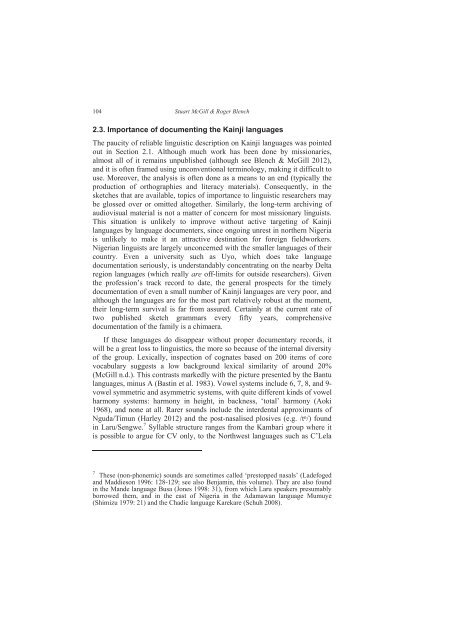Documentation, development, and ideology in the ... - Roger Blench
Documentation, development, and ideology in the ... - Roger Blench
Documentation, development, and ideology in the ... - Roger Blench
Create successful ePaper yourself
Turn your PDF publications into a flip-book with our unique Google optimized e-Paper software.
104<br />
Stuart McGill & <strong>Roger</strong> <strong>Blench</strong><br />
2.3. Importance of document<strong>in</strong>g <strong>the</strong> Ka<strong>in</strong>ji languages<br />
The paucity of reliable l<strong>in</strong>guistic description on Ka<strong>in</strong>ji languages was po<strong>in</strong>ted<br />
out <strong>in</strong> Section 2.1. Although much work has been done by missionaries,<br />
almost all of it rema<strong>in</strong>s unpublished (although see <strong>Blench</strong> & McGill 2012),<br />
<strong>and</strong> it is often framed us<strong>in</strong>g unconventional term<strong>in</strong>ology, mak<strong>in</strong>g it difficult to<br />
use. Moreover, <strong>the</strong> analysis is often done as a means to an end (typically <strong>the</strong><br />
production of orthographies <strong>and</strong> literacy materials). Consequently, <strong>in</strong> <strong>the</strong><br />
sketches that are available, topics of importance to l<strong>in</strong>guistic researchers may<br />
be glossed over or omitted altoge<strong>the</strong>r. Similarly, <strong>the</strong> long-term archiv<strong>in</strong>g of<br />
audiovisual material is not a matter of concern for most missionary l<strong>in</strong>guists.<br />
This situation is unlikely to improve without active target<strong>in</strong>g of Ka<strong>in</strong>ji<br />
languages by language documenters, s<strong>in</strong>ce ongo<strong>in</strong>g unrest <strong>in</strong> nor<strong>the</strong>rn Nigeria<br />
is unlikely to make it an attractive dest<strong>in</strong>ation for foreign fieldworkers.<br />
Nigerian l<strong>in</strong>guists are largely unconcerned with <strong>the</strong> smaller languages of <strong>the</strong>ir<br />
country. Even a university such as Uyo, which does take language<br />
documentation seriously, is underst<strong>and</strong>ably concentrat<strong>in</strong>g on <strong>the</strong> nearby Delta<br />
region languages (which really are off-limits for outside researchers). Given<br />
<strong>the</strong> profession’s track record to date, <strong>the</strong> general prospects for <strong>the</strong> timely<br />
documentation of even a small number of Ka<strong>in</strong>ji languages are very poor, <strong>and</strong><br />
although <strong>the</strong> languages are for <strong>the</strong> most part relatively robust at <strong>the</strong> moment,<br />
<strong>the</strong>ir long-term survival is far from assured. Certa<strong>in</strong>ly at <strong>the</strong> current rate of<br />
two published sketch grammars every fifty years, comprehensive<br />
documentation of <strong>the</strong> family is a chimaera.<br />
If <strong>the</strong>se languages do disappear without proper documentary records, it<br />
will be a great loss to l<strong>in</strong>guistics, <strong>the</strong> more so because of <strong>the</strong> <strong>in</strong>ternal diversity<br />
of <strong>the</strong> group. Lexically, <strong>in</strong>spection of cognates based on 200 items of core<br />
vocabulary suggests a low background lexical similarity of around 20%<br />
(McGill n.d.). This contrasts markedly with <strong>the</strong> picture presented by <strong>the</strong> Bantu<br />
languages, m<strong>in</strong>us A (Bast<strong>in</strong> et al. 1983). Vowel systems <strong>in</strong>clude 6, 7, 8, <strong>and</strong> 9-<br />
vowel symmetric <strong>and</strong> asymmetric systems, with quite different k<strong>in</strong>ds of vowel<br />
harmony systems: harmony <strong>in</strong> height, <strong>in</strong> backness, ‘total’ harmony (Aoki<br />
1968), <strong>and</strong> none at all. Rarer sounds <strong>in</strong>clude <strong>the</strong> <strong>in</strong>terdental approximants of<br />
Nguda/Timun (Harley 2012) <strong>and</strong> <strong>the</strong> post-nasalised plosives (e.g. /t/) found<br />
<strong>in</strong> Laru/Sengwe. 7 Syllable structure ranges from <strong>the</strong> Kambari group where it<br />
is possible to argue for CV only, to <strong>the</strong> Northwest languages such as C’Lela<br />
7 These (non-phonemic) sounds are sometimes called ‘prestopped nasals’ (Ladefoged<br />
<strong>and</strong> Maddieson 1996: 128-129; see also Benjam<strong>in</strong>, this volume). They are also found<br />
<strong>in</strong> <strong>the</strong> M<strong>and</strong>e language Busa (Jones 1998: 31), from which Laru speakers presumably<br />
borrowed <strong>the</strong>m, <strong>and</strong> <strong>in</strong> <strong>the</strong> east of Nigeria <strong>in</strong> <strong>the</strong> Adamawan language Mumuye<br />
(Shimizu 1979: 21) <strong>and</strong> <strong>the</strong> Chadic language Karekare (Schuh 2008).
















